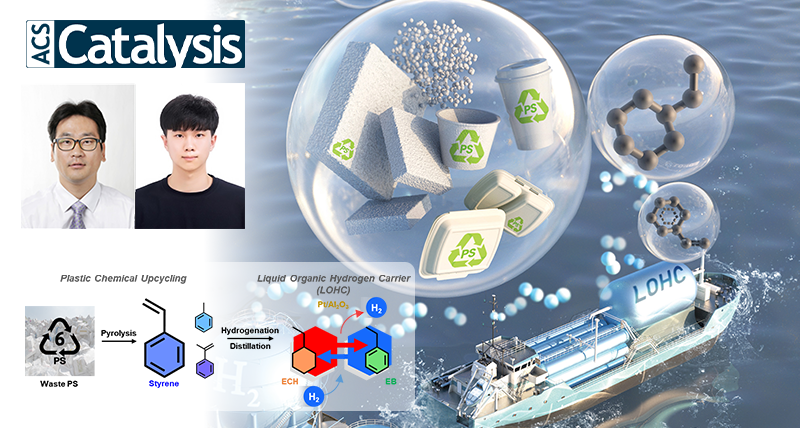A team of researchers in South Korea has introduced a method that leverages post-consumer polystyrene (EPS, Styrofoam) waste—of which less than one percent is recycled—to produce liquid organic hydrogen carriers (LOHCs). This approach aims to confront two persistent challenges in the clean-energy transition: the low recycling rate of polystyrene and the difficulties of storing, transporting, and using hydrogen at scale.
By converting aromatic monomers derived from polystyrene into hydrogen-rich cyclic hydrocarbons, the system promises safer ambient storage and use of existing liquid fuel logistics. Yet, technical, economic, and durability hurdles remain before industrial deployment is assured.
The process begins with thermal decomposition (pyrolysis) of polystyrene into low-molecular-weight aromatic compounds such as styrene and toluene. These aromatic monomers are then hydrogenated to form cyclic LOHCs (notably compounds like ethylcyclohexane). When needed, hydrogen is released by catalytic dehydrogenation. The research highlights ruthenium catalysts for the hydrogenation phase and platinum catalysts for the release phase. Crucially, the support material for the platinum is shown to affect both activity and stability—“nanosheet-assembled alumina” supports deliver better hydrogen release performance and durability, attributed to favorable metallic Pt⁰ species, lower acidity of the support, and improved pore structure. Impurity contaminants and polycyclic precursors are filtered out via distillation to avoid catalyst deactivation (coking).
Life cycle assessment and techno-economic analysis conducted in the same study suggest that the overall environmental impact of producing LOHCs from polystyrene can be net negative in carbon terms under certain assumptions. That includes the use of waste heat and processing contaminants, which improves energy efficiency. The economic model projects that hydrogen transport costs via this LOHC route could rival existing hydrogen transport methods — provided that catalyst lifetimes are extended, impurity removal is effective, and the scale is large.
However, several barriers must be addressed to transition from lab to industrial scale. First, the hydrogen storage capacity (gravimetric and volumetric) of these LOHCs is not yet clearly reported in large-scale field trials, and is generally lower than compressed or liquified hydrogen in pure form; efficiency loss in conversion cycles matters. Second, costs associated with high performance noble catalysts (particularly platinum) and their supports remain high; degradation (e.g., via coking) still forces periodic regeneration or replacement, even with impurity control via distillation. Third, scale-up is challenged by the supply and consistency of waste polystyrene feedstock; contamination, mix of additives, and pre-treatment steps impose both cost and quality burdens. Fourth, even if LOHC transport works well, end-use dehydrogenation must be efficient and safe under relevant pressures, especially for applications requiring high purity hydrogen (fuel cell use, industrial uses).
Potential pathways to surmount these challenges are evident. One is optimizing catalyst supports to improve stabilitiy and reduce cost of Pt usage, perhaps by exploring non-noble metal alternatives or alloyed catalysts. Another is integrating upstream sorting, pre-treatment, and purification of polystyrene waste to minimize contaminants and polycyclic intermediates. Waste heat recovery and energy integration, as the researchers demonstrated, can substantially cut external energy needs. Policy support—whether in the form of incentives for LOHC‐capable infrastructure, regulation on plastics recycling that rewards higher value reuse rather than downcycling, or standards for hydrogen purity—will be crucial. Industrial trials that assess full-chain costs (from collection of polystyrene waste, feedstock stabilization, LOHC synthesis, transport, dehydrogenation, and final hydrogen utilization) will be needed to validate the techno-economic projections.
This method of converting EPS waste into LOHCs offers a promising angle: combining waste management and hydrogen storage in a single loop, reducing plastic pollution while mitigating some of hydrogen’s logistical constraints. As efficiencies improve, catalysts scale, and policies align, such approaches may become complementary to other hydrogen storage strategies—compressed gas, liquified, or solid-state—but whether they can reach sufficient scale and cost-competitiveness remains a central question for industry and investors alike.
Stay updated on the latest in energy! Follow us on LinkedIn, Facebook, and X for real-time news and insights. Don’t miss out on exclusive interviews and webinars—subscribe to our YouTube channel today! Join our community and be part of the conversation shaping the future of energy.
